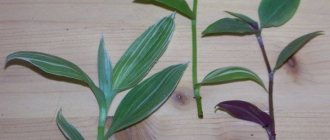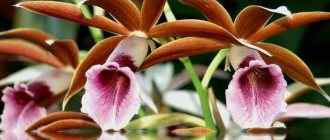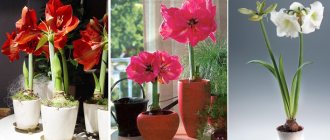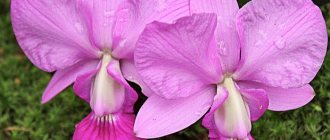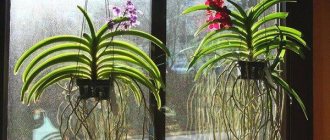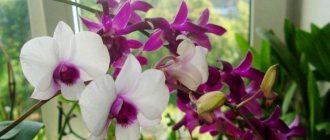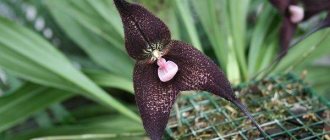Characteristic
Biologists do not have a consensus on whether plants with black petals occur in nature. Many are sure that no, and similar orchids were obtained through selection.
The genus Phalaenopsis can surprise with unusual colors
In fact, if you look closely, you will see that Phalaenopsis black is actually dark purple, maroon or dark blue. This type includes different varieties.
Black bird
The plant is not tall, about 40 cm. The flowers themselves are small, up to 4 cm in diameter. The color is rich blueberry, almost black.
Note! Flowering duration is 8 months.
Black Prince
The most beautiful representative. It has the darkest petals, which have a white core. The diameter of the flowers is 7 cm, the length of the peduncle is up to 50 cm. The leaves of this species are almost invisible.
The Phalaenopsis Prince variety will be appreciated by true connoisseurs of orchids. The number of flowers on one stem depends on the care of the plant and the conditions of its maintenance. If they are properly organized, the plant will bloom profusely.
Black Pearl
The leaves of the variety are almost emerald green, and the number of flowers on one stem reaches four. The petals are purple-burgundy.
Black phalaenopsis orchid Black Pearl looks very impressive
Black Widow
The inflorescences are small, they are collected on a peduncle of 3-4 pieces. The petals are a rich dark blue that looks like black.
Magnificent black phalaenopsis: photos and names of varieties
Among the great variety of amazing flowers that amaze the imagination with their splendor, the most mysterious to this day are black orchids.
They are ambiguous and mysterious, which is why they arouse great interest among flower growers. In the article we will look at varieties of phalaenopsis with dark, almost black flowers, give them a brief description and describe the features of caring for them.
People are always attracted to things that cannot be explained. So, there is still debate about how the black phalaenopsis appeared, who discovered it, whether it was created by nature or is it the work of breeders.
It is worth saying right away that in nature there is no pigment that can color flower petals black. It is always deep blue, burgundy or purple, so deep that the human eye perceives this color as black.
Some scientists believe that black orchids were bred by scientists at the University of California, but again, these are just guesses, which cannot yet be confirmed or refuted.
! There is a legend that the first black orchid was stolen by a botanist researcher from a tribe in South America, for which he was subjected to severe torture. However, this fact has not been documented in any way, so it remains a beautiful myth.
Regions of distribution in nature
Orchids with dark flower pigmentation live in the same regions as other varieties. They prefer a tropical climate, warm and humid, which contributes to their prolific flowering and active reproduction.
Phalaenopsis in the wild live by attaching their photosynthetic roots to other plants, feeding on mineral elements from the atmosphere.
Phalaenopsis Black Prince: photo and description
This orchid is considered the blackest among flowers known to scientists ; in fact, the petals are painted with a dense purple pigment with light markings on the core. can reach 45 – 47 cm in height , grows in one trunk, belongs to the phalaenopsis, which feeds on photosynthetic leaves and roots.
The unusual flowers of this beauty can reach 7 cm in diameter ; the number of buds blooming simultaneously on the peduncle can vary, depending on the conditions of detention.
Orchid black prince (photo of flowers). Variety - Ever Spring Prince 'Black Swan'.
Dyeing black
There is an artificial way to turn any orchid into an amazing specimen with black flowers. This method is used by flower growers who grow this flower for sale.
To do this, a special coloring pigment is injected into the core with a syringe , due to which the color of the orchid petals changes.
Black butterfly
On the long peduncle of Phalaenopsis Butterfly there are clusters of medium-sized flowers of a thick wine shade with small light speckles , their petals resemble the wings of a fluttering butterfly, which gives the plant an airy, light exotic look.
Dtps. Black Butterfly.
Black Swan
This orchid is distinguished by narrow fluttering flowers of a deep, almost black color . It does not have any special care requirements other than those required by all representatives of this species. It was described above in the text at the very beginning of the article.
Doritaenopsis Ever Spring Prince "Black Swan" - Black Swan.
The black pearl is the result of the painstaking work of breeders , thanks to which we can enjoy the sight of this amazing flower. During the flowering period, it produces up to four peduncles , each of which produces up to 15 small (5 cm in diameter) tulip-shaped flowers with a delicate spicy aroma.
Against the background of dark green elongated leaves that die off during the dormant period, these delicate, strong, deep purple flowers look very impressive.
Black Pearl.
Black bird
a height of 26–40 cm , produces one peduncle, on which blueberry-colored, waxy, dense flowers are formed, characterized by a long flowering time.
Black Bird.
Midi Harlequin
Harlequin is distinguished by its unpretentiousness and resilience. These flowers are given an amazing appearance by light spots of various shapes, appearing in a chaotic manner.
Photo of phalaenopsis Harlequin Mini, dark in color.
Mamba
This type of phalaenopsis forms one peduncle , on which there are up to 10 blue-black flowers with a white core.
It can reach a height of 40 cm ; the rosette of thick, dense dark green leaves emphasizes the beauty and exoticism of this plant.
Black Mambo.
Black trezor
Phalaenopsis with burgundy waxy flowers reaching a diameter of 6 cm has long been the dream of many gardeners. The color of the petals is so thick that visually the flowers appear almost black.
It is unpretentious in care and has the same requirements for growing conditions as other varieties of phalaenopsis.
Phalaenopsis Black Tresor.
The unique morphological properties of black phalaenopsis do not distinguish them from other representatives of this species, and therefore require the same care.
Watering, fertilizing and stimulating the flower
Phalaenopsis should be watered as needed. To understand whether the plant needs it, it is necessary to conduct a visual inspection of the root system: a signal that the flower needs watering will be the color of the roots - they become gray-green.
The phalaenopsis on the right needs watering.
You need to be very careful with feeding this flower; it should be done during the budding period , while mineral mixtures can be applied either to the green mass or by dissolving them in irrigation water.
Stimulation for flowering, which gives the greatest result, is artificially maintaining the required length of daylight hours.
Pruning after flowering
When the last flower on the peduncle dries, it is removed, but do not cut off the peduncle itself , because after a while buds may form on it again. It should only be removed when it dries.
Prevention of diseases and pests
The most effective prevention of diseases is the correct care algorithm , maintaining the desired temperature and watering regime.
Phalaenopsis reacts very sharply to excess moisture and low temperatures, this can cause disease of the root system.
By avoiding such stress, you can easily and without much difficulty keep your phalaenopsis in a healthy and active state.
After the purchase
The main thing to remember is that a change in growing conditions is stressful for any plant, so to begin with, you should not take active actions, feed, replant, or rearrange. Therefore, after purchasing, the main thing is to give the flower time to get comfortable and get used to its new home.
Regular visual inspection, timely watering and plenty of heat are what the newly acquired phalaenopsis needs.
Useful videos
p> with care after purchasing a black phalaenopsis: This video talks about Black Tresor:
Below is dedicated to the Black Bird Orchid:
This video shows another black phalaenopsis - Black Sentra:
Landing
Phalaenopsis orchid - home care
The black orchid had a magical effect on many.
For your information! T. Ford was so captivated by the unusual plant that he named a new perfume in its honor. The film of the same name is also popular.
Tom Ford perfume never loses its relevance. Therefore, many people are looking for the plant that inspired him to create a composition. But for an orchid to bloom, special conditions are needed.
Planting is carried out in loose soil. To do this, mix crushed dry bark, coal, sphagnum, and peat. All components are taken in equal parts.
The pot should be 1-2 cm larger than the root system. A container that is too spacious is not needed, otherwise the plant will begin to actively develop green mass.
Description of black orchid species
Black orchid... What is it about it that could win the hearts of millions and set it apart from all the diversity of orchids in the world? After all, each variety has something to surprise admirers of floral beauty.
The mysterious flower attracts with its delicate vanilla aroma. Black orchid flowers, playing with different highlights, enchant with their sophistication. Each variety has something unique.
Nowadays, scientists are proud of dozens of new names. Let's look at the features of the most beautiful and sought-after ones.
Maxillaria schunkeana
This rare species exists in all its pristine nature in the wild. Its specimens were found in the Brazilian Espirito Santo on the Atlantic coast of the tropical forest at an altitude of 700 - 3500 m above sea level.
Characteristic features are short stature, small flowers and lack of odor. The stems and foliage grow to a maximum of 25 - 30 cm, and the flowers reach a diameter of about 1.5 - 2 cm. The color of a dark orchid in poor lighting really appears black, but if you look closely, a dark purple tint is noticeable. By the way, among all types of black orchids, this shade is the most saturated. It has four petals, opening to resemble the shape of a tulip. The inflorescences are located in the basal part. Since the length of the peduncle is about 3 - 5 cm, it seems that the maxillaria appear directly from the bulbs.
In indoor conditions, the plant prefers warm, moderately humid air. The root part requires careful treatment, since any unprofessional intervention threatens damage to the kidneys and their deterioration. Also, the flower will not forgive you for swampy slurry in the pot. It is recommended to plant such unique plants in small bowls.
Fredclarkeara After Dark Black Pearl
The species is the result of a complex interspecific hybridization of Catasetum, Mormodes and Clovesia. A mature orchid produces four peduncles, each with 10 to 15 flowers up to 5 cm in diameter. Black flowers with a sweet spicy aroma resemble the shape of tulips; a brush forms on the peduncle. The leaves are succulent, bright green, and die off in the winter.
After hibernation, the roots, together with the stem, produce a kind of pseudobulb, which is a thickened sprout. It contains concentrated reserves of useful substances. When the green biomass finishes growing, inflorescences form. As a rule, this period falls on October - November. The juiciness of the petals lasts up to 8 weeks. A typical feature of the variety is the periodicity of flowering. When caring, it prefers moderately warm temperatures and bright lighting. Cultivated at home without problems
It is important not to overdo it with watering and fertilizing during the period of shedding leaves. It is better not to disturb the plant at this time.
Paphiopedilum Pisgah Midnight
Of all the types of black orchids, these are distinguished by the darkest dense tones. The blooming inflorescences are monochromatic, often dark purple, with clear black veins visible on the petals. When exposed to sunlight, a pleasant burgundy tint appears on them. The shape of the flowers resembles a shoe made up of three petals. The throat is crimson with a smooth transition to scarlet, the middle is yellow. In care, the flower is no different from other paphiopedilums. The plant needs a substrate made of tree bark and a transparent container, frequent air humidification, timely watering and fertilizing.
Paphiopedilum de Nachtwacht
A dark burgundy orchid shimmers with a brown tint in the sunlight. On a long peduncle, no more than two large shoe-shaped flowers appear simultaneously. The leaves are small, elongated, bright, contrasting against the background of the dark peduncle. For the flowerpot to fully develop, the room temperature should be between 18-22 degrees. Like all paphiopedilums, this variety requires loose, well-drained soil.
Phalaenopsis Black Butterfly
The black orchid from the genus Phalaenopsis received the name of the variety due to its dark petals that resemble wings
butterflies. The magnificent flowering clusters have a rich wine hue. The delicate white specks on the lip add sophistication to the flower. Under favorable conditions, small specks appear on the edges of the petals. The leaves are oblong, succulent, dark green. The peduncle is long. It is characteristic that all the lower flowers are dark, condensed shades, and the higher they are located, the lighter their petals.
Watering
Blue orchid - description, varieties, care
Phalaenopsis orchids need moist soil. Therefore, in summer the pot is watered 2-3 times a week. It is advisable to plant the plant in a transparent container, this will allow you to observe the condition of the roots.
Important! If the roots turn green, this indicates a lack of moisture.
You can use the tray irrigation method. To do this, place the pot in a bowl of warm water and leave for 20 minutes. Afterwards, the orchid is pulled out and excess moisture is allowed to drain.
Rare varieties of phalaenopsis: Biondoro, Black pearl, Blue, Buddha
Under natural conditions, phalaenopsis grows in Southeast Asia. Has a very diverse range of colors . It can be either soft white or aggressive blue, pale pinkish and bright red.
The so-called “lip” of the flower stands out against the general background, the pattern of which can be striped, mesh or tiger. The shade of the plant and the color of the lip depend on its specific species .
Let's consider special varieties of phalaenopsis: Biondoro, Black pearl, Blue, Buddha.
Immediately appreciate the Phalaenopsis Biondoro in the photo.
Biondoro is a rare orchid with a greatly shortened stem.
Phalaenopsis, as a type of orchid, has up to 70 species. The Biondoro orchid belongs to the monopodial type.
External characteristics and features
It has a greatly shortened stem with wide, dense leaves. An adult plant ready for flowering has from 4 to 6.
The leaves are evergreen, but as they age they turn yellow and die. New ones appear in their place. The leaves are compact, medium in size and oblong in shape.
The peduncle grows long with well-developed axils. Its petals have an elongated oval shape.
Important! The Phalaenopsis biondoro flower, like all orchids, resembles a butterfly.
The buds themselves are large with a variety of shades. From yellow with a purple pattern to plain dark red. The aroma is pleasant, pronounced.
The appearance of the peduncle and its branching directly depends on the quality care of the flower.
The stem slowly but constantly grows upward and reaches a length of up to 45 cm.
One of the subspecies of this species is biondoro multiflora:
- It has oblong, ovoid leaves , bright green in color;
- Their size is 35-40 cm , quantity - on average 4 pieces;
- Flower up to 6 cm in diameter;
- The inflorescences themselves are large, blooming on a branched long peduncle;
- Number of flowers up to 15 on one brush;
- The sepals are cream or red interspersed with different shades.
Watch the video for an example of a healthy Biondoro orchid:
A little about black orchids
The following colors of orchids are familiar to us
- White,
- purple,
- orange,
- Reds.
The black tint of the flower causes considerable surprise .
Important! There is no pigment in nature that gives black color to a plant. Through breeding work in California, a black variety of orchid, Phalaenopsis black, was bred.
The black orchid is very popular among Hollywood stars. (Not Black Pearl pictured)
Characteristics and features
The black flower is particularly beautiful and is popular among famous Hollywood artists .
A plant with such a shade has also attracted the interest of experienced gardeners . After all, it is known that in nature there is no necessary pigment for flowers to have a black tint.
Orchid Black Pearl
Phalaenopsis Black Pearl has a fascinating effect on orchid lovers and has a magnetism unique to it.
Bloom
For full flowering, the plant must be provided with diffused light without direct sunlight and placed in a warm place.
When the room temperature drops below 16 degrees and there is a lack of light, the buds begin to fall off .
Advice! In autumn, in order for flower buds to form, the plant should be kept at a temperature of about 16 degrees, but not lower, for 1-2 months.
Orchid Black Pearl.
An air temperature of 22-24 degrees is considered comfortable .
Subspecies of phalaenopsis with the word Black in the name :
- Black butterfly,Black butterfly.
- Black treasure,
- Black prince, Black prince.
- Black velvet,Black Velvet.
- Black mambo, Black Mamba.
- Black pearl.Black pearl.
They have flowers of dark burgundy and dark blue shades , which is why they are called black orchids.
The Black Butterfly orchid has fairly large inflorescences, the bud size is 7 cm. They have a pronounced dark burgundy hue.
The black orchid, developed by plant breeders in California, has a scent reminiscent of vanilla .
presentation of the orchid - Phalaenopsis Black Pearl:
This species is shrouded in many rumors and speculations. Indeed, some gardeners sell the Phalaenopsis Royal Blue orchid variety, passing it off as blue . But in fact, it is a standard plant with painted white buds .
Are there blue orchids in nature? On orchid growing forums you can find information that there are varieties of Cattleya in natural blue color. This is roughly what they look like (photo taken from an interesting video about these beautiful flowers https://www..com/watch?v=y1W0cGt9DqM):
Blue Cattleya.
Distinctive features
Under natural conditions, orchids do not have the pigment that gives their flowers their blue color . Such a bright blue hue as that of the Blue variety, which is sold by some gardeners, cannot be achieved .
There are wild orchids with pale blue, lilac, pink-blue tints of blossoming buds.
Although these unsaturated colors are very rare for phalaenopsis and concern some plants with small flowers.
The technology of coloring standard white phalaenopsis blue appeared back in 2009 almost simultaneously in South Florida (USA) and in the south of Holland, as a result of long experiments and experiments, and spread almost throughout the world.
In nature, phalaenopsis does not have blue pigment. In most cases it is artificial paint.
The dyeing process itself and the type of dye are hidden from consumers. In a nutshell, it is described as follows: phalaenopsis with white flowers are placed in chambers with a specially created environment from natural elements.
As a result, the blossoming buds acquire a blue tint using a method that is safe for the plant.
Important! Manufacturers in the characteristics of the Blue variety warn that further flowers will be white.
Watering and coloring plants at home
Phalaenopsis Blue will retain the blue color of the buds until the end of flowering . This period can be extended by watering it correctly.
The orchid should not be watered often - once a week is enough. In this matter, you must adhere to one rule - water after the substrate in the pot has completely dried.
The frequency of watering is mainly affected by:
- Indoor air humidity,
- The quality of the substrate in the pot,
- Pot volume.
At home, it is better not to paint so as not to destroy the plant.
As for the subspecies of Phalaenopsis Blue, the most common of them is Royal Blue :
- It has fleshy dark green leaves in the amount of 4-6 pieces;
- The buds bloom gradually on long curved peduncles, ensuring a long flowering period for the plant;
- The difference between the Aida Blue species is its love for placement in a bright place ;
- It should be watered by immersing the pot in water for a while;
- The Belina Blue variety occurs in nature with flowers of a delicate blue-violet hue;
- The number of leaves is from three to seven. They grow 25 cm in length and have pointed ends;
- Peduncle size – 15 cm.
Buddha
Buddha Orchid, flower photo.
Phalaenopsis of this species have one difference - the long life of the peduncle . It constantly grows from the apical bud after a period of dormancy.
Characteristics and distinctive features
On the peduncle of the Buddha variety, the number of blossoming buds is small. The plant, as it were, saves the energy accumulated for the constant flowering of the orchid. With a significant number of buds, the peduncle can quickly elongate, which is unacceptable for this variety.
The diameter of the Buddha bud is from 6 to 9 cm. The shape is round with five symmetrical ovoid petals.
Since the number of flowers is small, the peduncle should be short . After all, a long bare peduncle with several buds at the end would not look entirely aesthetically pleasing.
The distance from the leaves to the first blossoming bud is only 10 cm. See the decorative phalaenopsis buddha, flowering photo below.
In Buddha, the distance from the leaves to the first blossoming bud is only 10 cm.
Features of flowering
The limited number of flowers is compensated by the constant growth of new peduncles on which the buds ripen:
- Orchids of this species have the property of growing new flower stalks when the old ones have not yet dried out;
- For the Buddha variety, the possibility of branching the peduncle . This leads to an increase in the number of flowers;
- This variety belongs to the miniature variety. Its diameter together with leaves is 15-20 cm ;
- A characteristic feature is a very short peduncle . Therefore, such a plant does not look very attractive in a standard orchid pot;
- It is better to keep it in an epiphytic culture ;
- “Buddha” blooms quite quickly , but the flowers themselves are not as lush and beautiful as those of standard varieties.
Against the general background, this variety stands out with a short peduncle and is perceived as some kind of unique exotic specimen of an orchid.
Buddha orchid review:
These varieties watered sparingly throughout the year, especially in winter.
It is necessary that the roots have time to dry before the next watering. If you do not follow this rule, the plant may lose its roots from rotting and may also contract a fungus .
More important than watering and fertilizing is high air humidity in the room where they are kept.
Conditions of detention
They must be kept in bright areas of the windowsill or in the back of the room with good lighting. Comfortable temperature for a flower is +20-25°C.
Advice! During the period of stimulating flowering, a temperature difference should be ensured (4-5 degrees between day and night).
Air humidity should be at least 40 percent.
Disease Prevention
Preventive measures to combat diseases include proper care:
- Protection from direct sunlight. They can burn the tender leaves of the orchid;
- Protecting the flower from excessive moisture caused by frequent watering;
- Avoiding hypothermia.
The orchid is susceptible to both low temperatures and steaming. If she remains in such conditions for more than 11 hours, she will die.
The whole truth about blue orchids on video:
Useful tips
Elevated temperatures and excessive humidity negatively affect the condition of orchids . It is necessary to ventilate the room more often , do not place them close to each other.
should not be allowed to remain on the peduncle and leaves for a long time.
Source: https://komnatnie.com/orhid/phal/sortaf/redkies/biondoro-black-pearl-blyu-budda.html
Reproduction methods
The easiest way to propagate is by dividing the bush. When transplanting, the pseudobulbs are carefully separated and placed in different pots. The black orchid also reproduces by cuttings. To do this, select flower stalks after flowering.
Ludisia orchid: main types and home care options
They have dormant buds. It is with them that you need to cut off a section of the stem. After which the cuttings are planted in the ground and covered with a glass jar.
Note! Orchids also reproduce by seeds, but this is impossible to do in an apartment.
Basic rules for growing orchids
- For orchids, drafts pose a great danger; direct rays of the sun are also contraindicated for them. Therefore, you should carefully choose a place for the plant. In summer, it is better to take the flower out into the fresh air; in winter, the temperature in the room must be maintained at least 14C.
- Any heating devices are dangerous for the orchid, as they dry out the air greatly. Remember that phalaenopsis love moisture both in the soil and in the air.
- You can prepare the soil for the plant yourself, or you can buy a ready-made substrate, which must contain peat and pine bark.
In addition, the intensity of care for a black orchid will depend on the time of year. The plant enters its next period of vegetative growth at the end of February. At this time, it can be replanted if the roots have already grown greatly. From mid-March, the orchid enters the phase of active growth, just at this time it can be propagated by dividing the bush.
Black orchids do well in a room where the air humidity is at least 40%. If the air is too dry, the plant's flowers will fall off and the leaves will become lethargic. To save the orchid from drying out, it must be placed on a tray with water.
Remember, despite all the love for moisture, its excess will lead to mold and rotting of the root system. You can avoid this by ventilating the room where your orchids are located.
If the orchid does not bloom
If you are faced with a black orchid that does not want to bloom at all, then you need to determine the exact reason.
- Adaptation stage. Black phalaenopsis takes much longer to adapt to new conditions. Be patient and watch.
- Orchid age. These representatives of the flora usually bloom in the second or third year of life. Wait for your flower to “mature”; if you follow all the rules of care, it will definitely bloom.
- Length of daylight. If the day lasts less than 12 hours, then the plant does not have enough time for the buds to ripen. You can increase daylight hours using artificial lighting with special lamps.
- Daily temperature difference. A large difference between day and night temperatures can also negatively affect flowering. Make sure that fluctuations do not exceed 6-7C.
- Small capacity. If the plant has grown greatly, then this is another reason why the orchid refuses to bloom. Replant the flower, change the soil.
Transfer
You can replant the orchid only after flowering has ended. To do this, carefully remove the plant from the pot.
During transplantation, you need to act carefully, as the roots are easily damaged.
The roots are inspected and damaged parts are removed. Afterwards, the orchid is planted in a new pot, which is then placed in a dark place for 3-4 days. This is necessary for the plant to rest and cope with stress.
Note! Orchid flowers have an unusual shape. They are very sensitive to changes in living conditions, so replanting cannot be done during the flowering period. It is only needed once every 2-3 years, since the bark in the ground has a long service life.
Step-by-step instruction
The exotic black orchid is a whimsical plant that requires careful care. For it, it is necessary to create conditions as close as possible to the tropical habitat that is familiar to this flower. The flower needs a sufficient amount of:
- Sveta;
- moisture;
- heat.
Potty care
Caring for an exotic plant growing on a windowsill includes:
- Maintaining optimal temperature conditions. It should be at 18-22 degrees Celsius.
- Sufficient lighting. The orchid needs a lot of light, but does not tolerate direct sunlight. On a hot afternoon, the plant should be shaded or removed from the windowsill.
- Moderate watering. The exotic flower does not tolerate drought or waterlogging equally well. It is recommended to water it no more than 3 times every 7 days in the summer, and once a week in the cold season. In this case, it is necessary to periodically check the soil moisture; excess water in the soil can cause rotting of the root system.
Important! Standard soil is not suitable for planting. The soil should be loose and simple.
You can prepare the substrate from soil mixed with:
- pine bark;
- peat moss Sphagnum;
- vermiculite.
It is advisable to use as additional components:
- coir;
- perlite;
- chopped fern root.
By feeding
The black orchid needs additional nutrients during growth and budding. At the same time, fertilizers should not be used during the dormant period; this will reduce the protective properties of the plant and lead to the appearance of diseases and parasitic insects.
For feeding, you need to choose special fertilizers for orchid plants. The composition must be used as follows:
- Dilute according to instructions in clean, settled water.
- Moisten the surface of the substrate, being careful not to get it on the leaves.
- Fertilize no more than once every 2-3 weeks.
By transfer
Plant transplantation should be carried out according to the following scheme:
- Prepare a suitable pot.
- Make a loose substrate.
- Sterilize tools for cutting damaged areas.
- Grind activated carbon tablets to treat sections.
- Water the flower generously so that its root system becomes elastic and less likely to break when removed from an old container.
- Shake off excess soil from the roots. If the transplant is associated with infection of the flower, then all old soil must be thoroughly shaken off. To do this, you can rinse the roots under running water and dry them on a napkin for a quarter of an hour.
- Inspect the rhizomes. Cut off rotten areas, treat the cut areas with crushed activated carbon. If the root has completely rotted, it is advisable to cut it off entirely and hang the plant over a container of water so that it takes on new roots.
- If the root system is completely healthy, you can move the orchid to a new pot and cover it with substrate.
- Place the flower in a warm place with sufficient lighting. Do not water.
Important! It is not allowed to replant the plant during flowering. Such manipulations will lead to the dropping of buds.
By reproduction
Orchids grown at home are propagated in the following ways:
- seedlings;
- dividing the bush;
- children's department.
Growing a flower from seeds is quite problematic. This requires special greenhouse conditions.
Among gardeners, the most popular propagation method is germination in special flasks (flasks with seedlings). To do this you need:
- Break the flask.
- Remove the seedlings.
- Rinse them with running water.
- Leave in a weak solution of manganese permanganate for several minutes.
- Place on a napkin and dry.
- Prepare the substrate.
- Place the seedlings in it, being careful not to deepen the leaves.
- Place the plant in suitable conditions at a temperature of 22 to 24 degrees Celsius. In this case, the tray must be filled with water, and the flower itself must be placed under a fluorescent lamp.
- As the substrate dries, the flower should be moistened by placing it in water for several minutes. If there are several seedlings, you can fill the tray with water containing a fertilizer containing nitrogen, phosphorus, and potassium. During this period, additional foliar feeding is required.
- As soon as the root baby appears, it can be separated. It is advisable if by this time it has formed its own root system and leaves.
- Sprinkle the cut area with crushed activated carbon.
- Plant the separated baby in the same way as the seedlings.
Pests and diseases
Various plants, even with good care, can be affected by parasites. But some pests appear only with improper care. If the level of humidity is insufficient, orchids are affected by spider mites. It can be easily identified by the cobwebs on the leaves.
Thrips can be easily identified by the larvae on the plant.
Sometimes aphids appear on orchids. It can be detected during a routine examination; these are small green insects. To get rid of these pests, use a soap solution. To do this, dissolve 100 g of laundry soap in 1 liter of warm water. The mixture is sprayed onto the plants.
An excess of moisture is dangerous, as is its lack. When overwatered, root rot develops, which can destroy the plant. It can be identified because the roots turn black and gray spots appear on the leaves. For treatment, the plant is replanted, the affected areas are removed and treated with fungicides.
Another sign of waterlogged soil is the appearance of black spots on the foliage. If this symptom occurs, you need to remove the diseased parts of the plant and stop watering for the time being.
Flowering period
During flowering, all plants are very sensitive to the environment. Therefore, during this period it is necessary to organize good care. Descriptions of varieties do not always give a complete picture of the beauty of certain specimens.
The approximate air temperature should be 22 °C and humidity 40%. To do this, the plant is not only watered abundantly, but also sprayed regularly.
Note! There is a little trick: you can place a bowl of water next to the pots. The moisture will evaporate and humidify the air.
The room with orchids is ventilated once a day. A constant supply of oxygen is important to improve flowering.
Orchids need long daylight hours. To do this, they are placed on the windowsill or illuminated with phytolamps. An orchid needs 12 hours of light per day. It can exude an unobtrusive floral aroma.
Black phalaenopsis is rarely found in collections, but such flowers are very unusual and beautiful. Not only Tom Ford was captivated by this plant. Such flowers can become the pearl of anyone’s home composition.
Existence in nature
- Orchids themselves, like flowering plants, leave few people indifferent. Delight and admiration. And here it is also black. The color of mystery, mystery and uniqueness;
- They talk a lot about them. They show videos and publish photos with love and trepidation. And with noticeable pride of the happy owners of such;
- Are there orchids with black flowers in nature? If they exist, where can I buy them? And how to care for it? The discussions and statements of representatives of opposing opinions are interesting: Those who deny this fact give serious arguments from scientists: There are no purely black genes in nature. This is convincingly proven by scientists. There are no such pigments - says science. So there cannot be exclusively black flowers;
- And the numerous orchids with black flowers available for sale - commercial brand. Take a close look at the flowers. You will see, at best, dark shades of burgundy and blue. There's a lot of money floating around.
- In addition to the stories mentioned, they will tell you many more to confirm the existence of such black flowers;
- Cattleya;
Black cymbidium.
And don’t forget about the art of photography and its possibilities. Lighting and background can change a lot.
